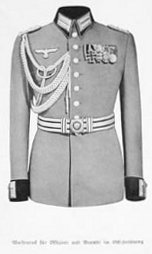Loading AI tools
Medieval German outer garment From Wikipedia, the free encyclopedia
Waffenrock (also German: Waffenkleid; English: surcoat or tunic) was originally a medieval German term for an outer garment,[1] worn by knights over their armor.[2]
This article has multiple issues. Please help improve it or discuss these issues on the talk page. (Learn how and when to remove these messages)
|

Later, Waffenrock became the generic term for any military uniform, including dress and parade uniforms, and also referred to epaulets or shoulder boards with rank insignia, as well as uniform cuffs, badges, and other insignia. As of 1945, the term is no longer in use by German-speaking armed forces, though the Swedish term for a military tunic is the cognate vapenrock.
Waffenrock was derived from the substantive wâfenroc or wâpenroc ("weapon tunic") of knights. It was often made from expensive silk cloth. The colors of this cloth corresponded to those on the shield quartering. In the spirit of this, the heraldic figures on the coat of arms were frequently designed with gold and silver embroidery.
In the Prussian Army, the service coat was commonly called Montierung. It was renamed to Soldatenrock ("soldier's tunic") in October 23, 1842, by the Prussian cabinet order of His Majesty (German: allerhöchste Kabinettsorder). In 1843, it was finally renamed to Waffenrock.[3] All German-speaking armies commonly used this wording, except for the Austro-Hungarian Army (later Austrian Army), where the designation Adjustierung was in use.
In its Wehrmacht form as issued in 1935, it was a formfitting thigh-length eight-button tunic of fine feldgrau wool, without external pockets. The collar was taller than the service tunic and bore more elaborate Litzen, embroidered all in silver-white and mounted on Waffenfarbe backing; smaller Ärmelpatten, similar in appearance to Litzen, appeared under the buttons on the dark-green Swedish cuffs. Waffenfarbe piping also edged the collar, cuffs, front closure, and scalloped rear vent.
Officers wore a formal belt of silver braid. Trousers were steingrau, with the outer seams piped in Waffenfarbe. In the full-dress uniform (grosser Gesellschaftanzug) the Waffenrock was worn with medals, aiguillette (officers), trousers and shoes, the Schirmmütze, gloves, and sword (officers/senior NCOs) or dress bayonet (enlisted). Parade dress substituted the steel helmet and jackboots. Semi-formal (kleiner Gesellschaftanzug) and walking-out (Ausgangsanzug) uniforms were as full-dress, but without aiguillette and with ribbons replacing medals.
Production and issue of the Waffenrock were suspended in 1940, and either the service or the officers' ornamented uniform was worn for dress occasions instead. However, the Waffenrock remained authorized for walking out for those who had or could purchase it. It was a widespread if unauthorized practice to loan a soldier a Waffenrock from regimental stocks to get married in, as evidenced by many wartime wedding photos.
The gallery below shows examples of Waffenrock over the suit of armor.
The gallery below shows Waffenrock examples until 1945.
Seamless Wikipedia browsing. On steroids.
Every time you click a link to Wikipedia, Wiktionary or Wikiquote in your browser's search results, it will show the modern Wikiwand interface.
Wikiwand extension is a five stars, simple, with minimum permission required to keep your browsing private, safe and transparent.